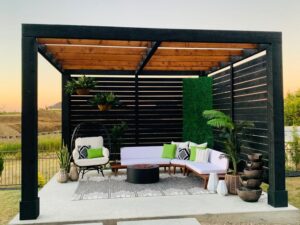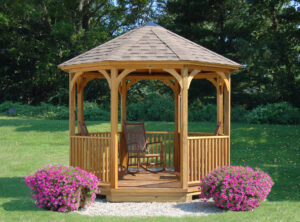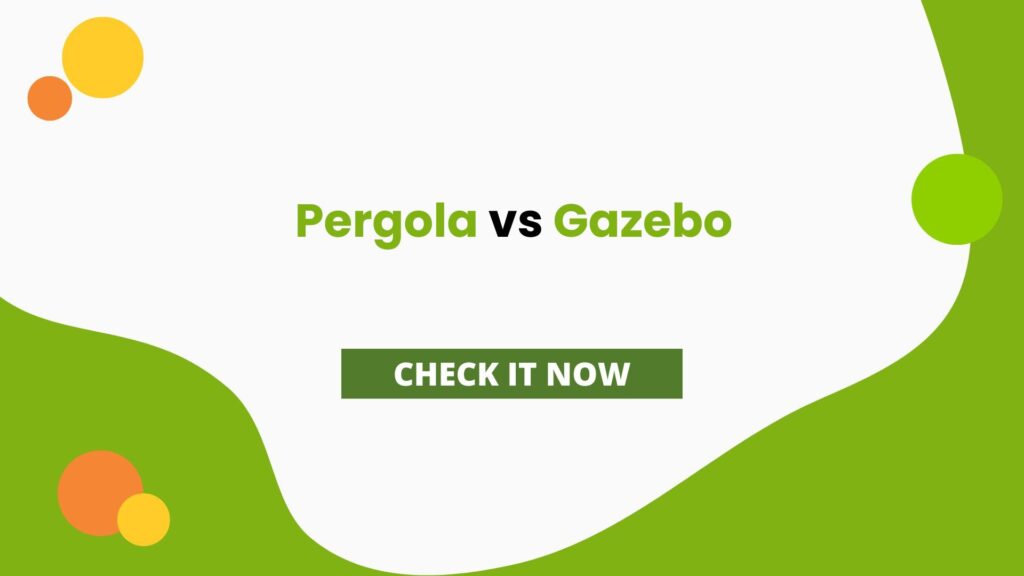When it comes to enhancing outdoor spaces, creating a sanctuary of comfort and aesthetic appeal is often the goal. Among the most popular choices for transforming a backyard or garden are pergolas and gazebos. These structures, while both designed to provide shade and style, offer distinct characteristics and benefits that can greatly influence the ambiance and functionality of an outdoor area.
Choosing between a pergola and a gazebo isn’t just about aesthetics; it’s about aligning with your lifestyle, understanding your spatial needs, and envisioning how you want to use your outdoor haven.
In this blog post, we will cover the differences between pergola vs gazebo, exploring their design, functionality, and suitability for various outdoor settings. So let’s start.

Table of Contents
ToggleUnderstanding Pergolas
Pergolas are open structures typically consisting of vertical posts or pillars that support crossbeams and an open lattice. This design allows for sunlight to filter through while providing partial shade. The open-air feel of a pergola makes it an ideal choice for those who wish to maintain a connection with nature while enjoying some protection from the elements.
Key Features of Pergolas
- Design Versatility: Pergolas can be customized in various shapes and sizes to fit different spaces, from small garden corners to expansive patios.
- Aesthetic Appeal: Often adorned with climbing plants like ivy or wisteria, pergolas can become a lush, green focal point in your garden.
- Material Options: Available in wood, metal, or vinyl, each material offers different benefits in terms of durability, maintenance, and appearance.
- Enhanced Ambiance: Pergolas can be fitted with lighting, drapes, or even retractable canopies to create a cozy, inviting atmosphere for evening gatherings or daytime relaxation.

Exploring Gazebos
Gazebos are freestanding, often octagonal structures with a solid roof and open sides. They offer full shade and more substantial shelter from the elements compared to pergolas. Gazebos are traditionally seen as elegant additions to gardens and parks, providing a distinct architectural element that can serve as a focal point.
Key Features of Gazebos
- Complete Shelter: The solid roof of a gazebo provides complete protection from sun and rain, making it a practical choice for all-weather outdoor activities.
- Architectural Beauty: With their symmetrical design and detailed craftsmanship, gazebos add a touch of elegance and sophistication to any outdoor space.
- Multi-Functional Space: Gazebos can serve various purposes, from outdoor dining areas and wedding venues to tranquil reading nooks or yoga spots.
- Permanent Structure: Often built as a more permanent fixture, gazebos can increase the overall value and aesthetic appeal of your property.
Main Difference Pergola Vs Gazebo
Here are five sentences that each highlight a different aspect of the differences between pergolas and gazebos:
- Pergolas have an open roof with beams or slats, while gazebos have a fully covered roof providing complete protection from the elements.
- Pergolas create a partially shaded area, making them perfect for garden focal points, whereas gazebos offer a fully enclosed space suitable for outdoor rooms.
- Gazebos stand out as distinct architectural features with their solid roofs and walls While Pergolas integrate seamlessly into landscaping and provide a more airy feel.
- Pergolas are often used to cover walkways or patios with climbing plants, while gazebos are typically freestanding structures used for seating and gatherings.
- Pergolas offer flexibility in their design and level of shade, whereas gazebos provide a consistent, sheltered environment regardless of weather conditions.
Choosing the Right Structure for Your Needs
When deciding between a pergola and a gazebo, consider the following factors to ensure your choice aligns with your lifestyle and preferences:
- Purpose: Think about how you plan to use the space. If you need a shaded area for outdoor dining or entertaining, a gazebo might be the better option. A pergola could be ideal for a more open, airy space that blends seamlessly with your garden.
- Climate: Consider your local climate. In areas with frequent rain or intense sun, a gazebo provides better protection. In milder climates, a pergola might offer just the right amount of shade and sun.
- Space: Evaluate the available space in your yard. Pergolas tend to have a more open and adaptable design, making them suitable for various locations. Gazebos, being more enclosed, require a dedicated spot.
- Maintenance: Reflect on the level of maintenance you’re willing to undertake. Wooden pergolas might need regular staining or sealing, while metal or vinyl options require less upkeep. Gazebos, depending on their material, also vary in maintenance needs.
By understanding the distinct characteristics and difference of Pergola vs Gazebo, you can make an informed decision that enhances your outdoor living space and complements your lifestyle. Whether you envision a verdant, sun-dappled retreat or a sheltered, elegant haven, both options offer unique opportunities to transform your backyard into a personal oasis.

